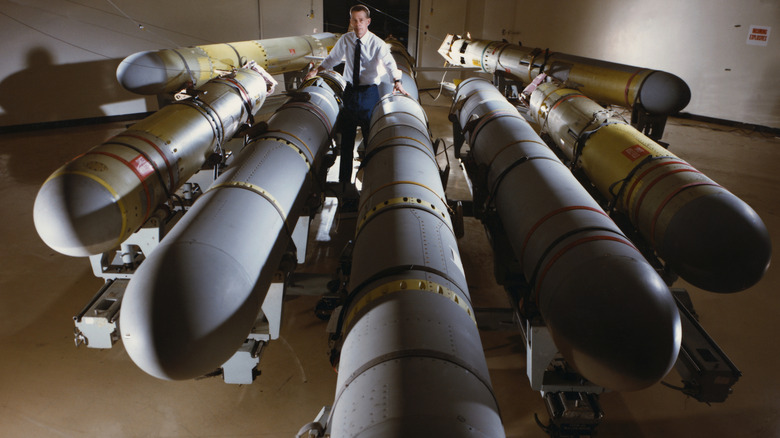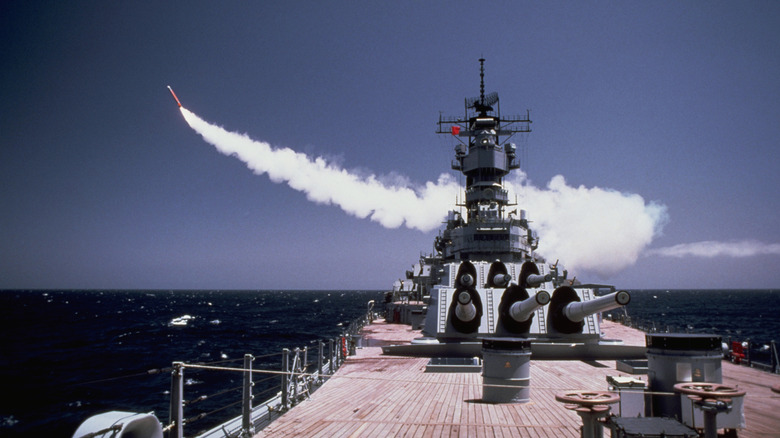How The Tomahawk Cruise Missile Gave Battleships A Second Life
Developed and built by General Dynamics and now by RTX Corporation (previously Raytheon Technologies) as a strategic strike and deterrent weapon, the Tomahawk cruise missile entered service in 1983. Because of its long range, accuracy, and adaptability, the Tomahawk missile is an important component in the U.S. military arsenal. Capable of precision strikes against enemy targets from a distance, it can carry a range of warheads, including conventional and nuclear payloads. It can be launched from several different platforms, including land-based systems, submarines, and ships. One of the most surprising uses of the Tomahawk missile was when it was fitted for use in World War II-era battleships.
During the Cold War in the 1980s, battleships from World War II were reactivated as part of an effort to equip the Navy with 600 ships during the Reagan administration. Considered capable of meeting the threat posed by Soviet Kirov-class battlecruisers and able to add to naval firepower, the vintage Iowa-class battleships were upgraded with the latest navigation, electronics, and weapons systems, including the Harpoon and Tomahawk missiles. Despite its age, the Iowa-class was considered a cheaper, faster, and more effective alternative than building new ships.
Designed in the 1930s, the iconic Iowa class of battleships, including the USS Iowa, USS New Jersey, USS Missouri, and USS Wisconsin, was considered the best battleship built. Because of its speed, destructive array of weapons, and its primary role as escorts for aircraft carrier task forces, it helped America win in the many engagements in which it participated in the Pacific theatre. For its 1980s refit, the Iowa-class battleships had a full displacement of 55,450 tons, 10,000 tons more than they had during WW2. Their dated anti-aircraft guns were also replaced with modern Phalanx close-in weapon systems.
Too expensive to keep afloat
By equipping the Iowa-class battleships with a powerful, long-range weapon system, the Tomahawk missile lengthened the battleships' service life. The reactivation of the battleships recalled the Iowa-class from being mothballed to active service. The modernization of the battleship made it capable and relevant in a new era of naval combat, which is seen when comparing the range of its former primary weapon, the 16-inch, 50-caliber Mark 7 guns, which had a maximum range of 27 miles, versus the installed Tomahawks. The new missiles included the anti-ship version with a 250-nautical-mile range, and the land attack version had a 700-nautical-mile range, which could be extended to 1,500 nautical miles if armed with a nuclear warhead.
It is worth noting that before the most recent refitting in the '80s, all four Iowa battleships, including the historic USS Missouri, were reactivated earlier during the Korean War, which lasted from 1950 to 1953, to target industrial and other strategic installations and were retired afterward. By the time of the Vietnam War, another Iowa-class battleship, this time the USS New Jersey, was recommissioned in 1968 and was tasked with bombarding enemy positions. After serving less than four months, the USS New Jersey was retired again.
On its second reactivation, the resurgence of the battleship lasted for 10 years, beginning in 1982 when the U.S. Congress approved the budget for its modernization up to 1992, when all four ships were finally retired. Despite the addition of modern systems, the improvement in the weaponry and capability of more modern cruisers rendered its role obsolete. More importantly, the advanced age of the ships and the required manpower to crew each one made its continued operation cost-prohibitive, finally retiring the battleships for good.

